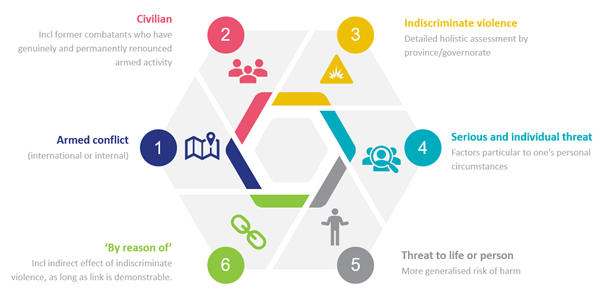Serious and individual threat to a civilian’s life or person by reason of indiscriminate violence in situations of international or internal armed conflict
GUIDANCE NOTE
Last updated: June 2022
The necessary elements in order to apply Article 15(c) QD are:
Figure 2. Article 15(c) QD: elements of the assessment.

In order to apply Article 15(c) QD, the above elements should be established cumulatively.
The following is a summary of the relevant conclusions concerning the situation in Iraq:
a. Armed conflict: There are multiple overlapping non-international (internal) armed conflicts taking place in Iraq, most prominently, the conflict between the Iraqi government and ISIL. Parts of Iraq are also affected by an international armed conflict involving Turkey, as the conflict in Turkey between Turkey and the PKK has extended to the northern Iraqi territory. The section Indiscriminate violence below provides further guidance with regard to the geographical scope of the armed conflicts taking place on the territory of Iraq.
It is important to underline that the assessment of protection needs is forward-looking. Therefore, the main issue at hand is whether the applicant will be a civilian or not upon return. The fact that the person took part in hostilities in the past would not necessarily mean that Article 15(c) QD would not be applicable to him or her.
c. Indiscriminate violence: Indiscriminate violence takes place to a different degree in different parts of the territory of Iraq. The map below summarises and illustrates the assessment of indiscriminate violence per governorate in Iraq. This assessment is based on a holistic analysis, including quantitative and qualitative information for the reference period (1 August 2020 – 31 October 2021). Up-to-date country of origin information should always inform the individual assessment.
Figure 3. Level of indiscriminate violence in Iraq (based on information up to 31 October 2021).

|
|
Mere presence would be considered sufficient in order to establish a real risk of serious harm under Article 15(c) QD. |
|
|
Indiscriminate violence reaches a high level and a lower level of individual elements is required to establish a real risk of serious harm under Article 15(c) QD. |
|
|
Indiscriminate violence is taking place, however not at a high level, and a higher level of individual elements is required to establish a real risk of serious harm under Article 15(c) QD. |
|
|
In general, there is no real risk for a civilian to be personally affected within the meaning of Article 15(c) QD. |
For the purposes of the guidance note, the governorates of Iraq are categorised as follows:
|
|
Territories where ’mere presence’ in the area would not be sufficient to establish a real risk of serious harm under Article 15(c) QD, however, indiscriminate violence reaches a high level, and, accordingly, a lower level of individual elements is required to show substantial grounds for believing that a civilian, returned to the territory, would face a real risk of serious harm within the meaning of Article 15(c) QD. This includes the governorates of Diyala, and the districts of Amedi and Zakho (Dohuk governorate). |
|
|
Territories where indiscriminate violence is taking place, however not at a high level and, accordingly, a higher level of individual elements is required in order to show substantial grounds for believing that a civilian, returned to the territory, would face a real risk of serious harm within the meaning of Article 15(c) QD. This includes the governorates of Anbar, Baghdad, Erbil, Kirkuk, Ninewa, Salah al-Din. |
|
|
Territories where, in general, there is no real risk for a civilian to be personally affected within the meaning of Article 15(c) QD. This includes the governorates of Babil/Babylon, Basrah, Dahuk/Dohuk (except the districts of Amedi and Zakho), Kerbala, Missan, Muthanna, Najaf, Qadissiya, Sulaymaniyah incl. Halabja, Thi-Qar/Dhi-Qar, Wassit. |
d. Serious and individual threat: In the context of the ‘sliding scale’, each case should be assessed individually, taking into account the nature and intensity of the violence in the area, along with the combination of personal circumstances present in the applicant’s case. Certain personal circumstances could contribute to an enhanced risk of indiscriminate violence, including its direct and indirect consequences. While it is not feasible to provide exhaustive guidance what the relevant personal circumstances could be and how those should be assessed, the following are highlighted as possible examples of circumstances which may impact the ability of a person to assess and/or avoid risks related to indiscriminate violence in a situation of an armed conflict:
- age
- gender
- health condition and disability, including mental health issues
- economic situation
- knowledge of the area
- occupation of the applicant and/or place of residence
- family members or support network
- etc.
e. Threat to life or person: The risk of harm as per Article 15(c) QD is formulated as a ‘threat to a civilian’s life or person’ rather than as a (threat of) a specific act of violence. Some of the commonly reported types of harm to a civilian’s life or person in Iraq include killings, injuries, abductions, retaliatory violence by the armed forces, forced displacements, forced recruitment of minors, explosive remnants of war, etc.
- harm which is directly caused by the indiscriminate violence or by acts that emanate from the actors in the conflict, and
- harm which is indirectly caused by the indiscriminate violence in a situation of armed conflict. Indirect effects are only considered to a certain extent and as long as there is a demonstrable link with the indiscriminate violence, for example: widespread criminal violence as a result of the collapse of State institutions in the context of the conflict with ISIL, destruction of the necessary means to survive, destruction of infrastructure.


